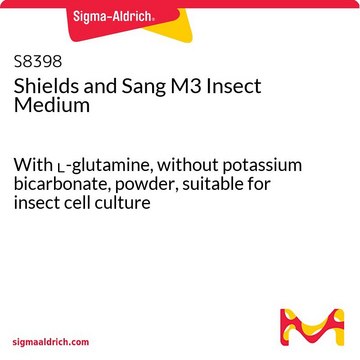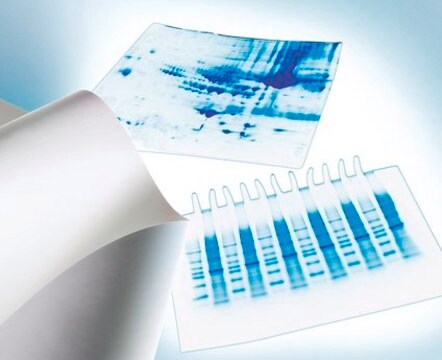S0146
Schneider′s Insect Medium
With ʟ-glutamine and sodium bicarbonate, liquid, sterile-filtered, suitable for insect cell culture
Sinonimo/i:
Schneider’s Drosophila Medium
About This Item
Prodotti consigliati
Nome del prodotto
Schneider′s Insect Medium, With L-glutamine and sodium bicarbonate, liquid, sterile-filtered, suitable for insect cell culture
Livello qualitativo
Sterilità
sterile-filtered
Stato
liquid
tecniche
cell culture | insect: suitable
Compatibilità
suitable for culture of other dipteran cell lines (Originally developed for the culture of Drosophila cells)
Componenti
NaHCO3: 0.4 g/L
glucose: 2 g/L (Dextro)
L-glutamine: 1.8 g/L
Condizioni di spedizione
ambient
Temperatura di conservazione
2-8°C
Cerchi prodotti simili? Visita Guida al confronto tra prodotti
Applicazioni
- to culture Drosophila neuronal cell line (BG3-c2 cells)
- to cultivate subcultures of Leishmania major for promastigote growth inhibition assay
- to seed purified ookinetes with Drosophila melanogaster S2 cells to assess the effect of the avermectin compound on cell development and to promote oocyte development
Comunemente ordinati con questo prodotto
Codice della classe di stoccaggio
12 - Non Combustible Liquids
Classe di pericolosità dell'acqua (WGK)
WGK 1
Punto d’infiammabilità (°F)
Not applicable
Punto d’infiammabilità (°C)
Not applicable
Scegli una delle versioni più recenti:
Possiedi già questo prodotto?
I documenti relativi ai prodotti acquistati recentemente sono disponibili nell’Archivio dei documenti.
I clienti hanno visto anche
Il team dei nostri ricercatori vanta grande esperienza in tutte le aree della ricerca quali Life Science, scienza dei materiali, sintesi chimica, cromatografia, discipline analitiche, ecc..
Contatta l'Assistenza Tecnica.







